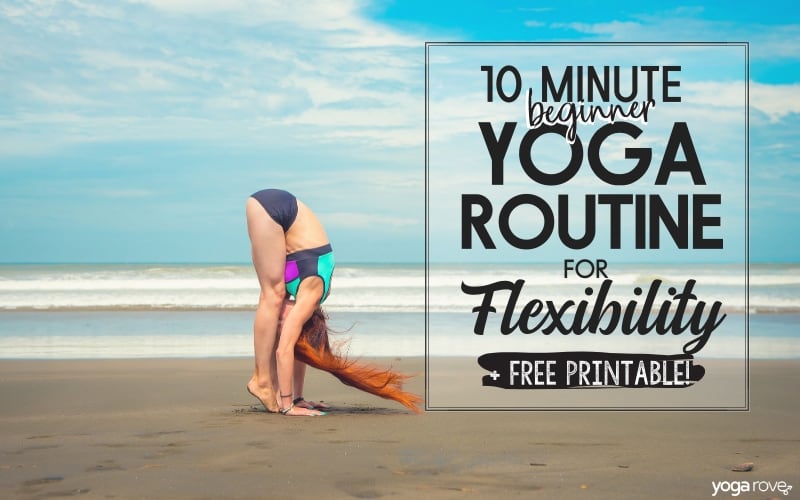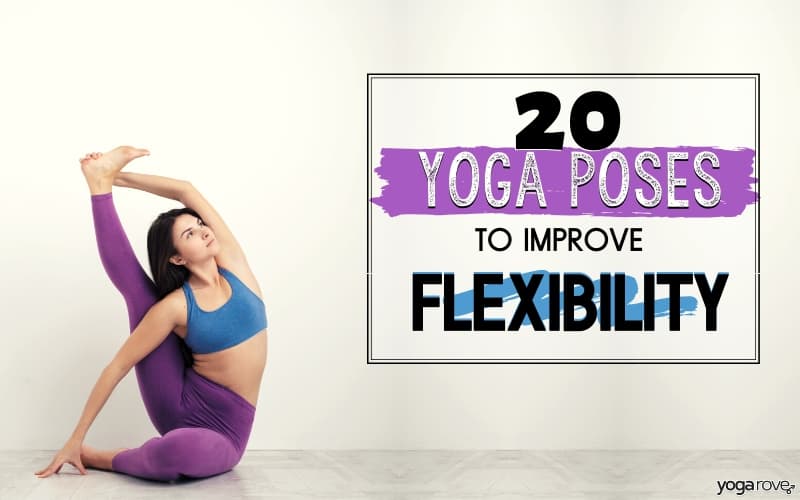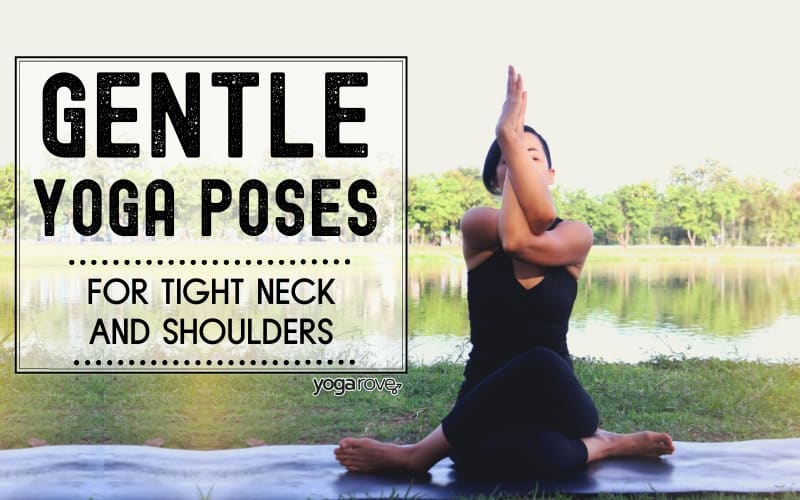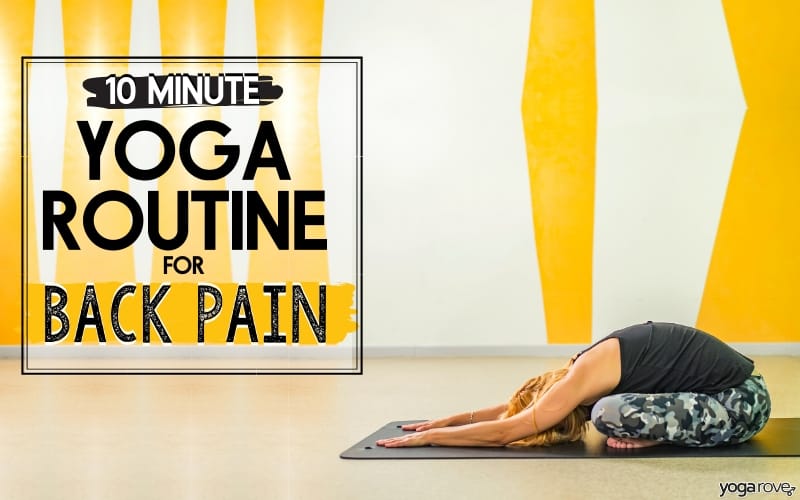This post may contain affiliate links. Please read our disclosure for more info.
I’ve recently gotten back into running for plans to run my first half marathon. After practicing yoga for many years and now running again has made me realize how important yoga is for runners. Every single person who runs should be practicing yoga consistently in order to avoid injury, reduce stiffness, and improve their overall running.
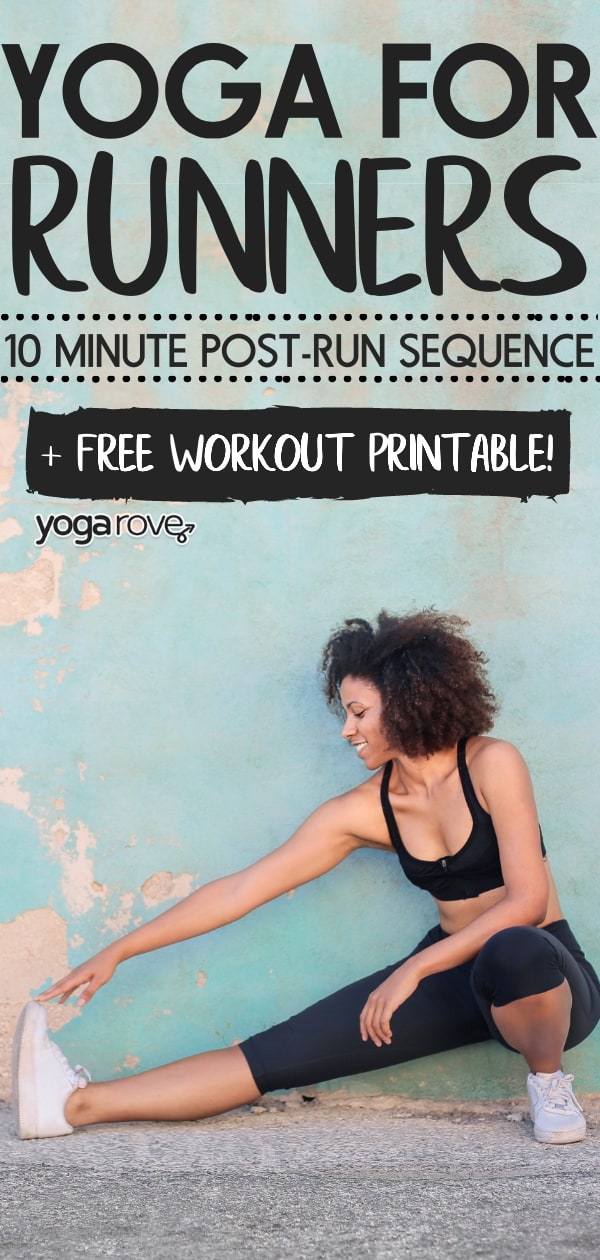
Why All Runners Should Do Yoga
Adding yoga into your routine as a runner has more benefits than you may realize! Here are a few:
1. Improves Range of Motion
Running is a repetitive motion, which can lead to tightening and tension in the muscles and decreased range of motion. Increasing your range of motion will make it easier for you to lift up your legs and run longer distances because an increased range of motion minimizes the amount of effort it takes to run.
2. Increases Muscular Strength and Endurance
Whenever you feel your form getting sloppy it is because your muscles are tired. And when you run with bad form, it will increase your chances of getting injured. This is why increasing your muscular strength and endurance using yoga will significantly reduce your running injuries.
3. Improves Breathing
Your breath is very important when you are running. If you lose control of your breath, you lose control of your run. In yoga, you practice breath work throughout the entire sequence. This breath training will allow you to have a more relaxed breathing pattern when you run and increase your overall run significantly.
4. Improves Balance and Posture
This goes back to having better form. When you are able to improve your posture by strengthening your muscles it will help you improve your form. Having great form when you run will allow you to run for longer distances and decrease your chances of getting injured.
5. Reduces Stress
Studies have proven that running increases cortisol levels, the infamous stress hormone. Although this is not necessarily bad for short periods of time, long term it can cause a lot of issues like weight plateauing or gain, depression, etc. Adding in an alternative exercise that decreases cortisol like yoga is great for stress relief, hormonal balance, and avoiding adrenal fatigue.
6. Strengthens Weak Muscles
If you strictly focus on running all the time for your workouts you are missing on the many opportunities yoga provides you to train muscles that will assist you in running. One of the most important muscles that runners tend to forget about is their core and upper torso.
Running for long distances causes your muscles to become tired as time goes on. If you do not strengthen your upper torso your form around mile 8 is going to look like crap and cause you to slow down or worse, get an injury.
7. Quickens Recovery Time
This is definitely my #1 reason for doing yoga after a run. If I ever skip a 10 minute yoga session after my runs my body feels the difference. Do your body a favor and commit to this 10 minute yoga routine after every run!
Is Yoga Better Before or After Running?
Yoga is perfect before and after you run. The thing is the yoga sequence you do before a run and after a run is going to be completely different from one another.
Whenever you are about to prepare for a run you are going to want to avoid long static type stretching. Over-stretching your muscles will end up causing injury to your body. The goal in a yoga sequence before a run it to get you warmed up and ready. Most poses will be held for shorter periods of time and you will find yourself “pulsing” while you are in the pose to activate the muscle.
After you run is when you are going to want to focus on holding poses for longer periods of time. This is essential for all runners because it is going to increase your recovery time and help you improve your future runs.
10 Minute Post-Run Yoga Routine for Runners
This is how the routine for your post-run goes:
- Downward Facing Dog– 30 seconds
- High Lunge– 30 seconds
- Crescent Lunge– 30 seconds
- Half Split– 30 seconds
- Lizard– 30 seconds
- Butterfly– 30 seconds
- Seated Straight Legged Forward Fold– 30 seconds
- Seated Wide Legged Forward Fold- 30 seconds
- Reclined Big Toe– 30 seconds
- Corpse Pose– 1 minute (after second round)
1. Downward Facing Dog
The repetitive motions of running can cause tight hamstrings, and having loose hamstrings is important to preventing injury.
Downward Facing Dog is a great yoga pose to loosen the tension and tightness in your hamstrings, you will feel the stretch immediately.
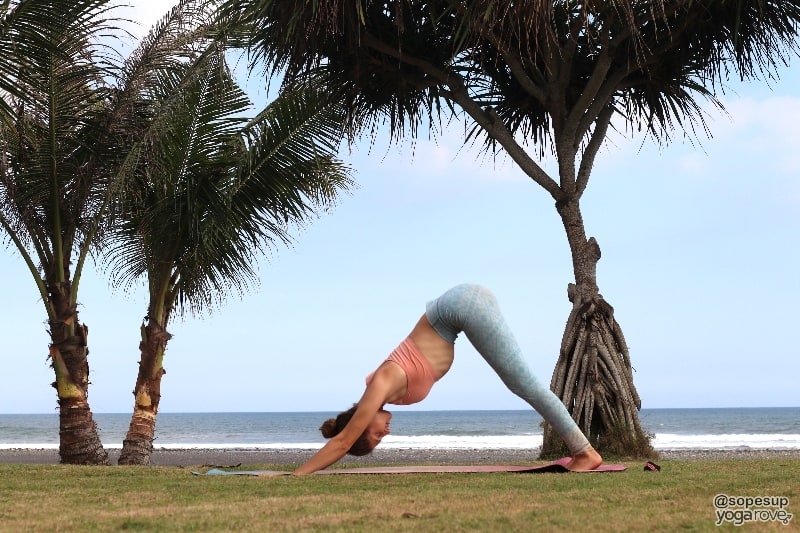
To do Downward Facing Dog:
- Get onto all fours with your wrists under shoulders and legs inner hip distance apart with your toes tucked.
- Send your hips up and back into the air. Ground through your hands and engage your upper body and core. Don’t let all the weight fall onto your arms by engaging your core and legs as well.
- If you have tight hamstrings, you won’t be able to get your feet to touch the ground and will feel a lot of tightness right off the bat. Try pedaling your feet out one at a time to loosen them up instead of holding the pose the entire time.
Benefits:
- Strengthens arms and upper back
- Stretch calves and hamstrings
- Opens up your hips and shoulders
- Helps balance your mind and body after a run
2. High Lunge
High Lunge stretches the inner hip and hip flexors. Runners tend to build up tension in this area as well from the repetitive motions. This will definitely help you release it!
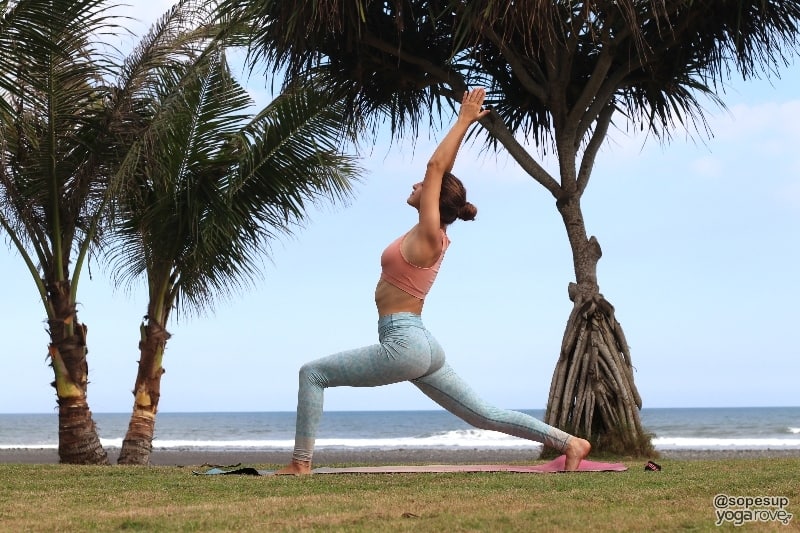
To do High Lunge:
- From Downward Facing Dog, bend your right leg and sweep it underneath you to the front of your body, in between your hands.
- You should be on your back toes now. Extend through your heel and engage your back leg so your kneecap lifts.
- Ground through your front foot and bend your right knee at a 90 degree angle with knee over ankle, then rise up using your core.
- Lift your arms up above your head and sink deeper into your front leg.
Benefits:
- Strengthens glutei and thighs
- Opens up the hip flexors
- Stretches the calf muscle
- Improves muscles around the knee to reduce pain
3. Crescent Lunge
This is definitely on my top list of favorite yoga poses because of how great it feels on the hip flexors. It stretches similar areas to High Lunge but the stretch is much deeper.
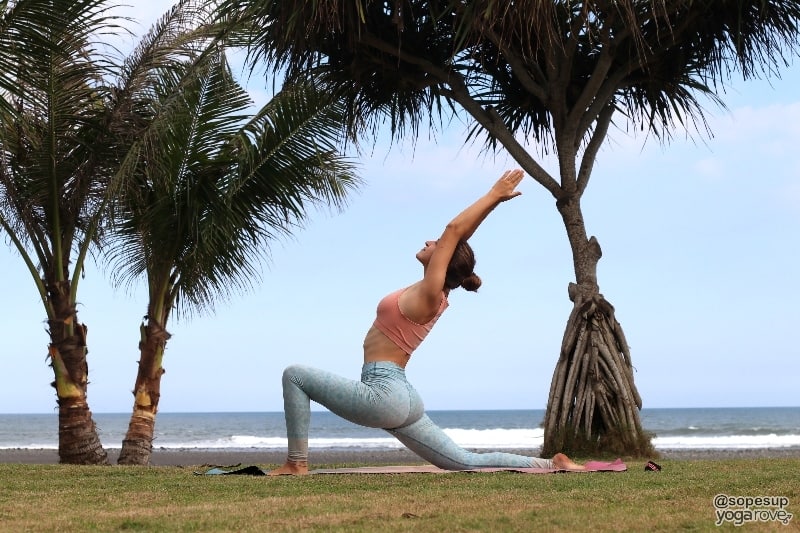
To do Crescent Lunge:
- Drop your back knee slowly to the ground from High Lunge. Untuck your back toes.
- You can either place your hands on your knee or up above your head. Sink forward into your right hip as you create a very slight backbend.
- Keep your chest lifted throughout the pose and your hips even.
Benefits:
- Opens up the chest
- Stretches the groin and hip flexors
- Strengthens glutei and hip muscles
- Improves balance and stability
4. Half Split
This pose deeply stretches your calves, thighs, and groin. This may feel a bit intense if you have never tried it before, which I would then recommend using blocks until you have done it a few times and released some tension.
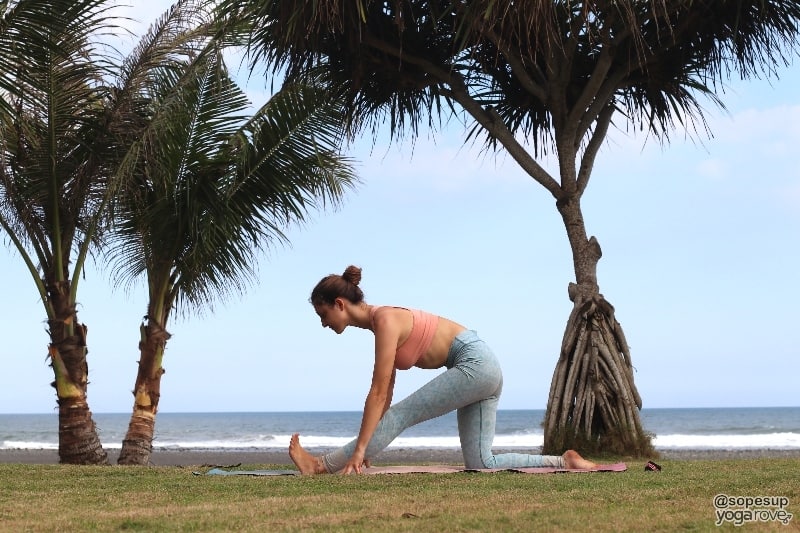
To do Half Split:
- From Crescent Lunge, straighten your front leg as you sink your seat slightly backwards over your leg.
- Flex your foot back towards you, and make sure your hips are even with each other. You may already start to feel a deep stretch here.
- Begin to slowly fold over your front leg keeping your foot flexed back towards you. Only go as far that is “comfortably uncomfortable”. You don’t want to feel actual pain, just a deep stretch. Place a block on either side of you as support to make the stretch milder.
I like to go through a flowing sequence between Crescent Lunge and Half Split just as you would in Cat and Cow. Just slowly move through the two poses, holding each for a few breaths, and repeat about three times.
Benefits:
- Stretches your hamstrings, claves, and achilles.
- Folding over helps release tension in your lower back and neck.
- Creating a flow from half split to present lunge is very beneficial to all runners.
5. Lizard
Lizard Pose works on your hamstrings, groin, and hip flexors, and can help strengthen the ligaments in your hips.
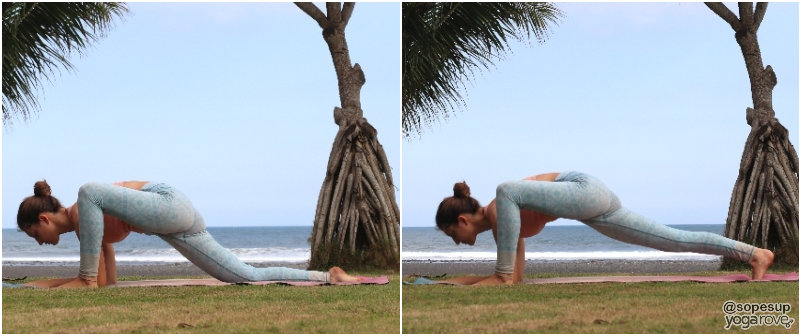
To do Lizard Pose:
- From Half Split, bend your front leg and bring it the the outside of your right hand, grounding it on the floor.
- Straighten your back leg out behind you, keeping the toes tucked or untucked. You can choose to tuck the toes and keep the leg lifted for a deeper stretch.
- Come down onto your forearms, making them parallel to each other with pals flat.
- Keep the chest lifted and be mindful not to put all your weight onto one side, try to keep the hips square.
Benefits:
- Best hip flexor stretch
- Helps open up the hips especially from those long runs
- This stretch preps you for deeper stretches.
6. Butterfly
Butterfly Pose is great for stretching the inner thighs, groin, and actually works on the lower back as well to relieve tension.
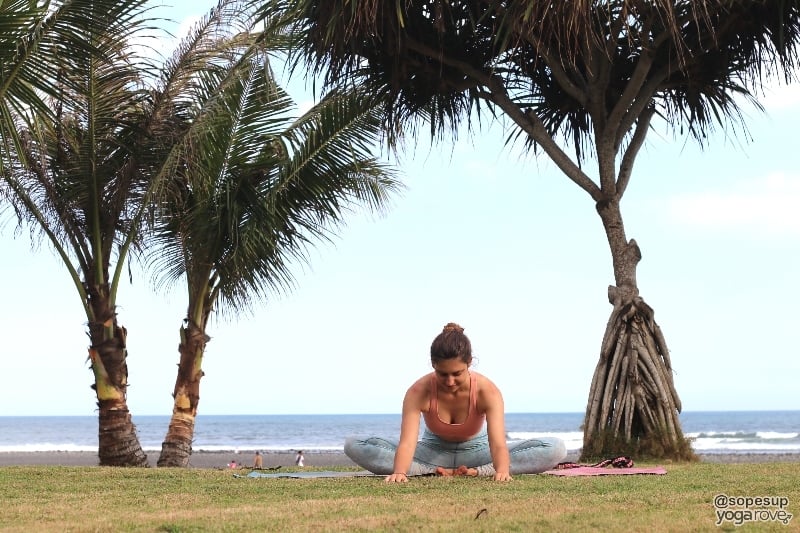
To do Butterfly Pose:
- Come to a seated position, sitting with a tall spine like in Easy Seat.
- Bring your feet together with the soles touching. The closer you bring you feet towards your body, the deeper the stretch. Adjust to what feels right for your body.
- Try using your hands to gently push your knees down to the ground. You can stay here if this is a deep enough stretch for you, or you can fold over your front body.
Benefits:
- Strengthens the pelvic floor muscles.
- Stretches groin area, inner thighs, and knees
- Helps release mild fatigue
- Reduces menstrual discomfort and sciatica
7. Seated Forward Fold
This is a relaxing pose that is great for improving flexibility in the hamstrings and thighs.
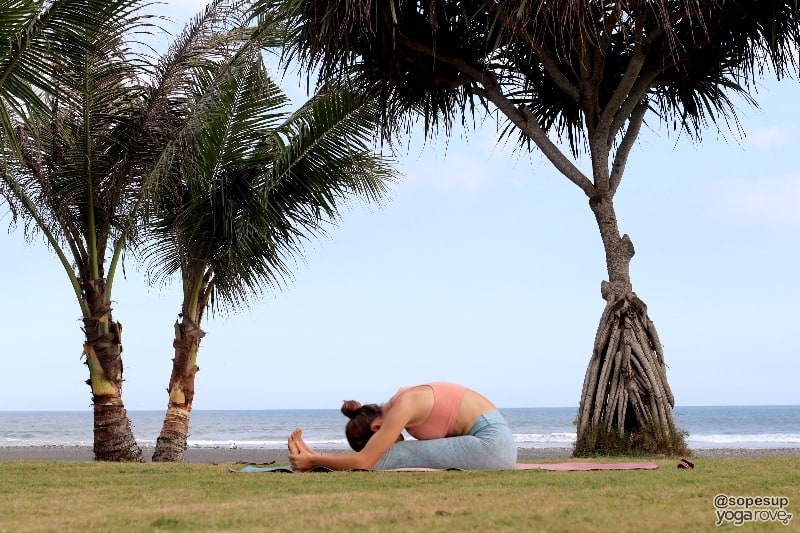
To do Seated Straight Legged Forward Fold:
- From Butterfly Pose, if you are folded, come back up to a seated position with a straight and tall spine.
- Straighten your legs out in front of you and flex your feet back towards you.
- On your next exhale, while keeping a flat back, slowly fold over your legs. You can grab onto your shins, ankles, or toes if possible.
- Make sure not to collapse through your chest or round the spine.
Benefits:
- Stretches lower and upper back
- Reduces neck pain
- Dropping your head bellow your heart calms the nervous system and emotions
8. Seated Wide Legged Forward Fold
This is similar to Seated Straight Legged Forward Fold except instead the legs are spread wide. This works more on the groin and hip flexors.
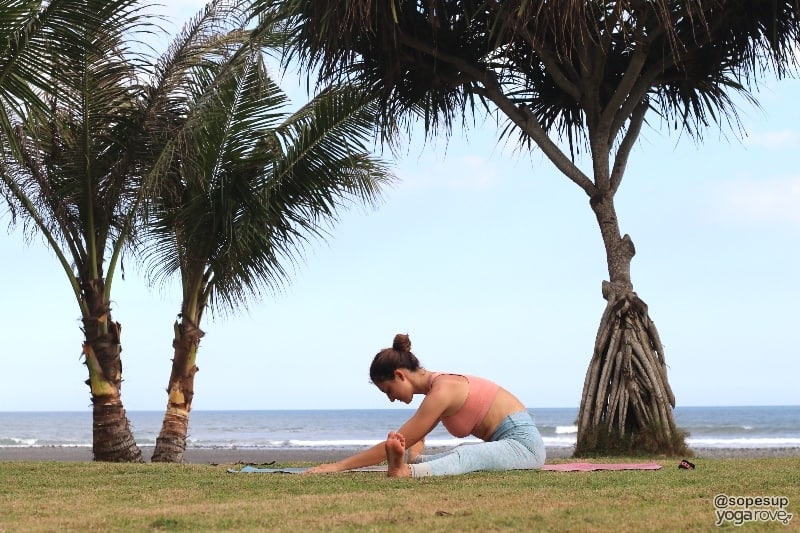
To do Seated Wide Legged Forward Fold:
- Come back up from your fold in Seated Straight Legged Forward Fold with a straight back.
- Bring your legs out as wide as you comfortably can and flex the feet back towards you.
- On your exhale, slowly walk your fingertips forward to fold over. Be mindful of how your body feels throughout the pose and adjust the width of your legs to what feels best for you.
Benefits:
- Stretches inner legs and groin muscle
- Lengthens the spine
- Stimulates the abdominal organs
9. Reclined Big Toe
For this pose you will need a strap, but you can also use a tie, belt, or practically anything around your house that is flexible and long. Yoga straps are super inexpensive though- you can check out the one we use on our Recommendations Page.
This pose deeply stretches your calves, thighs, and hips as well. My legs always feel so much better after I practice this pose.
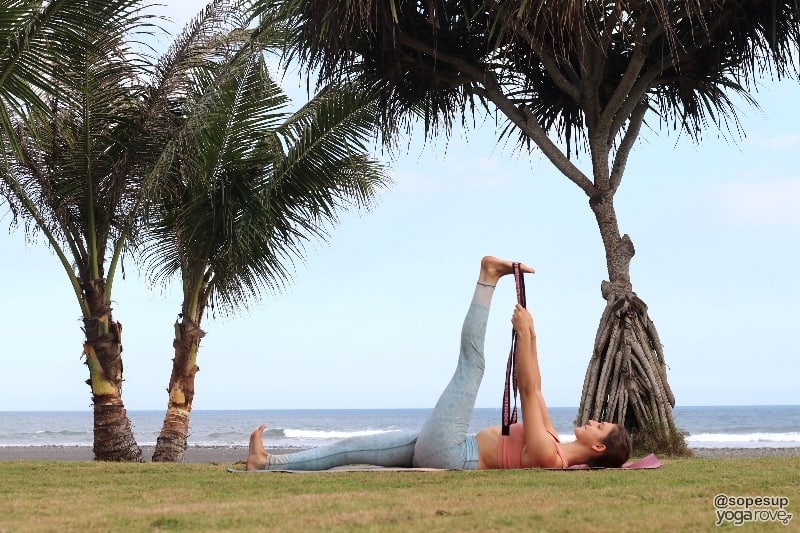
To do Reclined Big Toe:
- Lie on your back with legs straight out in front of you.
- Grab your strap and place the middle of your right foot inside of it.
- Keep both feet flexed towards you and straight. On your exhale, lift your right leg into the air, and pull back on the strap to pull your toes towards you.
- This stretch may feel intense for some at first. Adjust the intensity by how high you lift your leg and how strongly you pull back on the strap.
Your leg may start to shake. Mine usually does when I haven’t done this pose for awhile. That is just the tension being release.
Benefits:
- Releases a lot of tension built up in the hamstrings and calves.
- Great for opening up the hips
- Helps improve digestion
10. Corpse Pose
After you have completed this sequence on both sides, come into Savasana, or Corpse Pose. Do not skip this! This is so important for runners and anyone doing yoga to relax your mind and body from all the active stretching you just did.
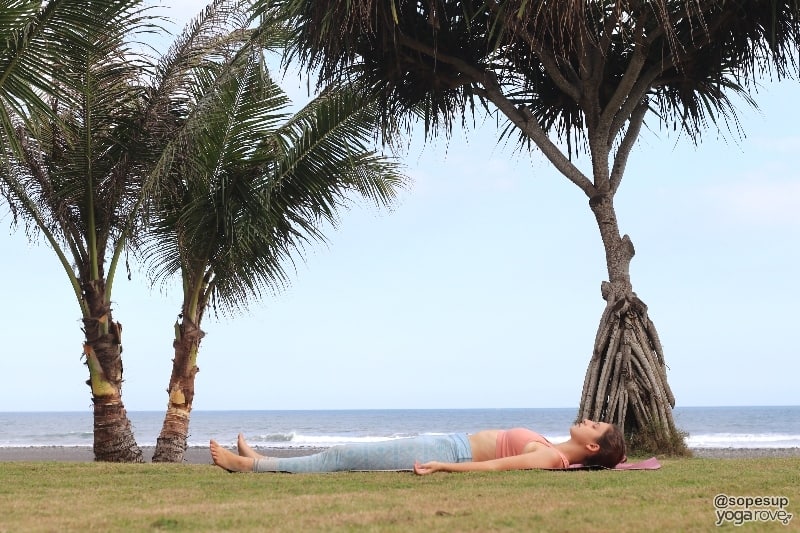
To do Corpse Pose:
- Come onto your back into a comfortable position. Close your eyes.
- Allow your feet to fall to the sides. Gently bring mindfulness to each part of your body and release any tension you notice you are holding in it.
- Stay here as long as your body and mind require. I recommend at least doing this pose for one minute, which can be challenging for people first starting out.
Adriene from Yoga with Adriene has the best video on how to “properly” do Corpse Pose below.
Benefits:
- Completely resets your body and mind to bring you in a state of rejuvenation.
- Releases stress, fatigue, and tension from your run
- Helps ground your body
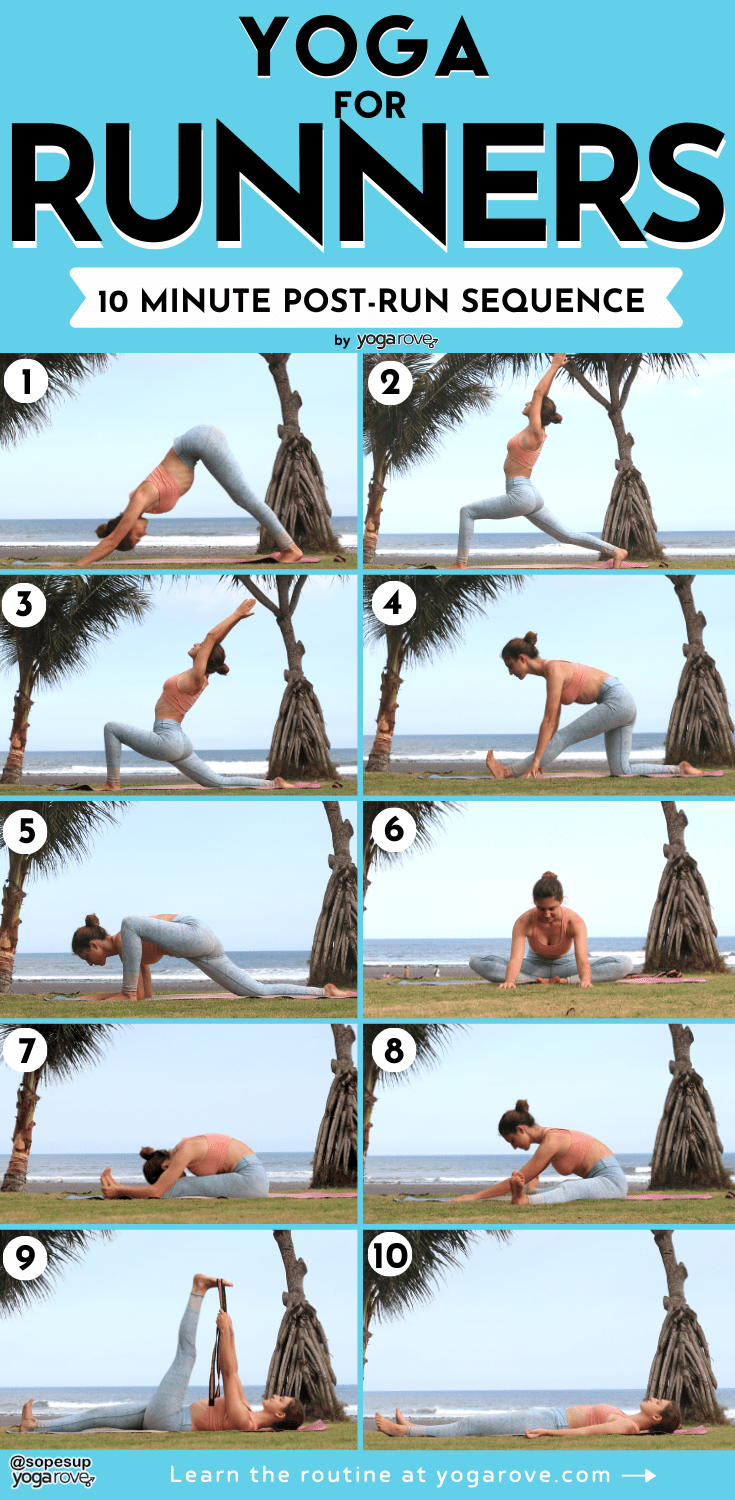
Try to make it a habit to practice yoga every time after your run. Just spending 10 minute can bring you so many benefits and make your running experience so much better.
Safe Yoga Habits for Runners
As a runner I enjoy pushing myself to increase my speed and endurance. In doing so I listen to my body and try to understand if the pain I am feeling is a good pain or a bad pain.
The thing with yoga is that you do not want to take the “no pain, no gain” approach. In doing so you will cause more harm then good to your body.
You have two different types of pain:
- Sweet Pain: happens when you are stretching and you feel the bulk of your muscle getting stretched out
- Bad Pain: this occurs when you feel a sharp pain due to your tendon or joint being injuried.
Remember to take it easy especially if you are new too yoga. Focus mostly on your breath and relaxing into the pose. In practicing this routine everyday you are going to notice a significant difference in your recovery time and a reduction with the injuries you have experienced.
Massage Tools for Runners
Rubz
This is a small ball that replicates acupuncture. I started using this tool when I was working on my feet during my 14 hour serving shifts. It is a very inexpensive tool that you can get on Amazon.
Take the ball and slowly roll your feet with it. Try not to over roll the feet because you may end up causing more harm then good. To prevent this from happening try to find tight areas in your feet and focus on just applying pressure by putting more of you weight on the ball.
Remember to breath nice and slow. Focus on the tension releasing in your feet as you apply pressure. When you first start using this ball you may feel discomfort based on the sensitivity of your feet, but I assure you that it will feel like such a relief once you use it more.
Foam Roller
Hands down one of the best ways to massage your entire body is with a foam roller. You can use a foam roller from your feet to your neck. Try to use this mostly for the bigger muscles of your body such as your thighs, calves, back, and hamstrings.
To gain a better understanding of how to use one I suggest looking at this video below.
Massage Stick
These are portable sticks that you can bring with you any where and get an amazing massage for your legs. Seriously the best investment if your calves are sore at the end of the day. It is also great for your thighs and neck.
If you have a friend or a partner that could help you out it allows people to give each an amazing back massage. I carry one with me in my back pack all the time because it allows my muscles to relax at the end of the day.
Go to Amazon and type in Tiger Tail Massage Stick. Purchase it and you will not be disappointed.
Lacrosse/Tennis Ball
Another cheap handy massage tool that is also always in my back pack is a lacrosse ball. The best way to use one is to find a wall and place the ball in between your back and the wall. Slowly begin to roll and find the knots in your back.
When you do find a knot take a deep breath and apply a lot of pressure as you breath out. Do this for multiple round to decrease the pain. If it is a pain in between your shoulder blades you will have to take a different approach.
These balls can also be used on your feet and any where else you find tension that needs releasing. This is also a great tool for a partner to use on you to help reduce back pain.
Check out some of the other articles below to diversify your yoga practice and don’t forget to sign up to our free resource library so you can print out the many routines that we offer so its easy to follow along.
Check out our other routines to keep your mind and body relaxed and feeling great:



